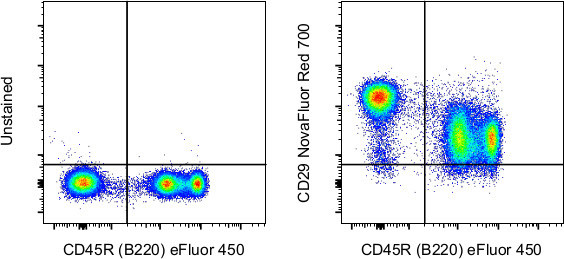Search Thermo Fisher Scientific
Invitrogen
CD29 (Integrin beta 1) Monoclonal Antibody (eBioHMb1-1 (HMb1-1)), NovaFluor™ Red 700, eBioscience™
图: 1 / 2
CD29 (Integrin beta 1) Antibody (M048T03R03-A) in Flow


产品信息
M048T03R03-A
种属反应
宿主/亚型
分类
类型
克隆号
偶联物
激发/发射光谱
形式
浓度
纯化类型
保存液
内含物
保存条件
RRID
产品详细信息
Description: The eBioHMb1-1 monoclonal antibody reacts with mouse and rat CD29 (integrin beta 1), a 110-120 kDa member of the beta integrin family expressed by leukocytes, endothelial, smooth muscle and epithelial cells. CD29 binds non-covalently with the alpha integrins CD49a-f to form the VLA-1 through VLA-6 complexes, as well as with CD51. These alpha-beta integrin heterodimers are capable of mediating a variety of cellular responses including adhesion, trafficking, proliferaton and differentiation. All integrins which include CD29 bind to extracellular matrix proteins including collagen, laminin, fibronectin and vitronectin, whereas some CD29-containing integrins can also interact with cellular receptors such as VCAM-1 and MadCAM-1.
Each product contains 1 vial of NovaFluor conjugate and 1 vial of CellBlox Plus Blocking Buffer .
Applications Reported: This eBioHMb1-1 (HMb1-1) antibody has been reported for use in flow cytometric analysis.
Applications Tested: This eBioHMb1-1 (HMb1-1) antibody has been tested by flow cytometric analysis of mouse bone marrow cells. This can be used at less than or equal to 0.2 µg per test. A test is defined as the amount (µg) of antibody that will stain a cell sample in a final volume of 100 µL. Cell number should be determined empirically but can range from 10^5 to 10^8 cells/test. It is recommended that the antibody be carefully titrated for optimal performance in the assay of interest.
NovaFluor dyes are not compatible with DNA intercalating viability dyes. Do not use viability dyes such as propidium iodide, 7-actinomycin D (7-AAD) and DAPI. Invitrogen LIVE/DEAD Fixable Dead Cell stains are recommended for use with NovaFluor dyes.
This NovaFluor conjugate has been updated to ship with CellBlox Plus Blocking Buffer (Cat. No. (C001T06F01)). This buffer contains formulation improvements over CellBlox. CellBlox Plus Blocking Buffer is required for optimal staining with NovaFluor conjugates and should be used in all experiments where NovaFluor conjugates are used. Whenever possible, we recommend adding CellBlox Plus Blocking Buffer to antibody cocktails/master mixes prior to combining with cells. Add 5 µL per sample (regardless of the number of NovaFluors in your panel) to use the antibody cocktail as intended. For single-color controls, use 5 µL of CellBlox Blocking Buffer per 100 µL of cell sample containing 10^3 to 10^8 cells.
NovaFluor conjugates are based on Phiton™ technology utilizing novel nucleic acid dye structures that allow for engineered fluorescent signatures with consideration for spillover and spread impacts. Learn more
Excitation: 639 nm; Emission: 700 nm; Laser: 633-640 nm (Red) Laser
靶标信息
ITGB1 (Integrin Subunit Beta 1, beta1 integrin subunit, GPIIa, CD29) is a 110 kDa cell surface glycoprotein that is widely expressed by a variety of cells including all leucocytes. ITGB1 forms non-covalently linked heterodimers with at least 6 different alpha chains (alpha1-alpha6, CDa-f) determining the binding properties of beta1 (VLA) integrins. ITGB1 is a cell adhesion molecule appearing on platelets, as the common Beta subunit of the very late activation antigen (VLA), and as a component of various protein complexes binding to extracellular matrix proteins. Decreased expression of ITGB1 correlates with acquiring multidrug resistance of tumor cells in the presence of anti-tumor drug. ITGB1 is up-regulated in leukocytes during emigration and extravascular migration and appear to be critically involved in regulating the immune cell trafficking from blood to tissue. Further, ITGB1 also regulates tissue damage and disease symptoms related to inflammatory bowel disease. Through an ITGB1-dependent mechanism, fibronectin and type I collagen enhance cytokine secretion of human airway smooth muscle in response to IL-1beta. More than 8 beta subunits with numerous splice variant isoforms have been identified in mammals. There are two major forms of integrin beta1: beta1A and beta1D, which differ in 13 amino acids. The distribution pattern in adult tissues for integrin beta types are mutually exclusive. Beta1A is present in all tissues, except cardiac and skeletal muscle which express the beta1D variant.
仅用于科研。不用于诊断过程。未经明确授权不得转售。
How to use the Panel Builder
Watch the video to learn how to use the Invitrogen Flow Cytometry Panel Builder to build your next flow cytometry panel in 5 easy steps.
篇参考文献 (0)
生物信息学
蛋白别名: Beta OL; Beta oligodendroglia; CD29; Fibronectin receptor subunit beta; integrin beta 1 (fibronectin receptor beta); Integrin beta-1; Integrin beta1; integrin VLA-4 subunit beta; ITBG1D; VLA-4 subunit beta
基因别名: 4633401G24Rik; AA409975; AA960159; CD29; ENSMUSG00000051907; Fnrb; Gm9863; gpIIa; Itgb1
UniProt ID: (Mouse) Q8BVU1, (Rat) P49134
Entrez Gene ID: (Mouse) 16412, (Rat) 24511




